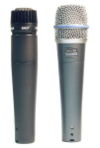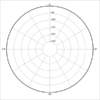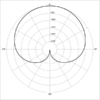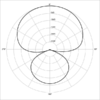Difference between revisions of "Sound for Interaction class 6"
(→Audio connectors) |
(→Tranducers) |
||
| Line 4: | Line 4: | ||
Block Diagrams (how audio moves though a system) | Block Diagrams (how audio moves though a system) | ||
| − | |||
| − | |||
==Audio Levels== | ==Audio Levels== | ||
Revision as of 15:54, 7 June 2007
Contents
Signal flow
Block Diagrams (how audio moves though a system)
Audio Levels
Good Level Audio Levels
- Mic level - The level (or voltage) of signal generated by a microphone. Typically around 2 millivolts. Compare this with the two normal line levels (1.228V:+4dBu and .316V:-10dBV)
- Phono Level - little larger than mic level also has equalization based on standardized RIAA curve. use phono input a line
- Line Level - . There is an international standard for the level of inputs; it is around -10dBV(.316V) for semi-pro equipment, and about +4dBu(1.228V) for "pro" equipment. Line level outputs can come from tape decks, CD players, tuners, DAT decks, effects, etc.
- Speaker level - higher voltages for speakers
Audio Level Links
Meters
Analog VU meter - nominal level 0dB 
Digital Meter - nominal level -12dB - 16dB 
Red line shows last Peak. Numbers at the top show loudest Peak.
Audio connectors
- 1/8" (3.5mm) Connectors Jack Plug Connectors Tip ring sleeve
 mono
mono  stereo
stereo 
- 1/4"(6.35mm) Connectors


- Banana Plugs

- Binding Posts Bayonet Neill-Concelman/British Naval Connector type of signal varies or BNC

- RCA-Type video left audio right audio



- XLR Microphone XLR

- TOSLink http://en.wikipedia.org/wiki/TOSLINK

Bluffers guide to WIRES AND CONNECTORS
Transducers
Transducer = a device that converts one type of energy to another. A microphone converts acoustic energy to electrical energy. A speaker converts electrical energy to acoustical energy. They are both transducers.
Microphones
good reading Audio Technica Guide to Microphones
Types of microphones
- Dynamic
- Condenser
- Ribbon
- piezo electric (contact Mic)
other (Stereo, binaural, PZM- pressure zone microphone http://www.crownaudio.com/mics.htm)
Ribbon Mic
- The first type of mic was a Ribbn Microphone. Basically a light wieght ribbon that conducts electricity the is suspened in between two magnets. Older ribbon mics usally have a reduced frequency response.
http://www.coutant.org/ribbons.html
Dynamic Mics
- A light weight diaphragm is connected to a coil that is suspended between a magnet.
- A very light weight diaphragm is suspended in front of an electrically charged back plate. The two plates basically act as an open air capacitor. As the air pressure changed the distance between the plated the capacitance between the plates also changes.
Condenser microphones need Phantom Power to work.
Our stereo mic: Audio Technica AT825 [1]
Microphone Comparison
| Parameter | Dynamic | Condenser | Ribbon |
| Frequency Response | Good | Best | Worst |
| Dynamic Range | Good | Good | Worst |
| Durability | Best | Good | Worst |
Proximity Effect
The frequency response of a directional microphone changes as it it brought close to a source. The bass response increases.
http://en.wikipedia.org/wiki/Proximity_Effect#In_audio
http://www.csun.edu/~record/prox/prox.html
Polar Patterns
http://en.wikipedia.org/wiki/Microphones#Microphone_polar_patterns
- Omni-directional - all directions
- Bi-directional (figure 8)- front and back rejects on the side
- Uni-directional - one direction
- Cardioid - one direction with lobe
- Hypercardiod - really one direction with lobe
http://www.mikelights.com/micpolar.htmlALC Microphone Directionality Some pictures
http://www.csun.edu/~record/polar.html Some more Pictures
Stereo Mic Techniques
Spaced Omni's - two spaces Omni mics
XY - Coincident cardioids at 90 degrees
ORTF (Office de Radiodiffusion -- Television Francaise)110 degrees 17cm apart - Near Coincident Pair About.com Microphones Part 1
Dat Heads mic-FAQ.txt
Audio Levels
Mic level - The level (or voltage) of signal generated by a microphone. Typically around 2 millivolts. Compare this with the two normal line levels (1.23V:+4dbV and .316V:-10dbV)
Phono Level - little larger than mic level also has equalization based on standardized RIAA curve. use phono input a line
Line Level - . There is an international standard for the level of inputs; it is around -10dBV for semi-pro equipment, and about +4dBV for "pro" equipment. Line level outputs can come from tape decks, CD players, tuners, DAT decks, effects, etc.
Speaker level - higher voltages for speakers Audio connectors
* 1/8" (3.5mm) Connectors
mono stereo
* 1/4"(6.35mm) Connectors
* Banana Plugs/Binding Posts
speaker level British Naval Connector type of signal varies
* RCA-Type
video left audio right audio
* XLR Microphone
Bluffers guide to WIRES AND CONNECTORS Recording stuff
Digital Media
Dat - Digital audio tape 2 track
MiniDisc -from Sony only
MDM (modular digital Multitracks)
Tascam - DA-88, DA-98, DA-38 (digital 8 track uses Hi-8 Media)
Alesis - ADAT, M20
sampler
akia MPC4000
Computer Based Sound Packages (Multitrack)
Hardware
Digidesign Pro-tools
Event
creative audigy
MOTU
Digital busses
Serial vs Parrallel
SPDIF - sony philips digital interface format RCA Cable
AES/EBU Audio Engineering Society/ European Broadcasting Union XLR or fiber
Toslink Audio equipment resouces Discussions
* Audio Forums.com * rec.audio.pro * alt.audio.equipment * alt.audio.pro.live-sound * more rec discussion rec.audio.*
software
* sharewaremusic.com -hitsquad blahhh * partnersinrhyme
reference
* audiovideo101
Multi-Track Mixing
Acid and multi track mixing
* Acid channel modes demo * Working with more than one track * Panning and Levels * Music Looping in sound forge
* Acid 3.0 interface * Other Acid tutorial
Audacity http://audacity.sourceforge.net/
Short demo of Sound Sculpture in Audacity
Project 2 - Radio Commercial Process
1. Record 3 takes of 30 Second Commercial
* Have talent practice Reading
* Set Level (~-8db)
* Record
* careful annunciation and consistent voice
* Save file to folder
2. Edit
* Edit for Quality
o Best parts of the three takes or fix trouble spots
o Remove unwanted noise
o Balance Volume
o Normalize - optional
* Time and Pacing
o Voice should be 29 seconds
o Add remove space between words,phases, sentences - meter?
o Time Compress Expand -optional
* Overall Voice Quality
o EQ -optional
o Compressor -optional
o Normalize -optional
3. Mix
* Select background music/effects
* Mix with voice watch for intelligibility
DirectX - non destructive real time effects like TDM but runs on CPU
DirectX and TDM effect are restricted by the amount of processing power.
TDM's run on a single dedicated processor and DirectX effects run on the CPU. We can only affect three thing Amplitude,Time,Frequency Amplitude
* Mute * Normalize * Fade (in/out/graphic) or Envelope * Compressor
Time
* Time Stretch * Pitch Bend/Shift
Frequency
* EQ
o http://www.canimi.com/webnew/audiospectruma.html
o EQ by the Octave
o Eq Primer
Show Reverb Assign Effects You book and these links may help http://www.harmony-central.com/Effects/audio-effects-faq-10.txt http://www.harmony-central.com/Effects/effects-explained.html http://users.iafrica.com/k/ku/kurient/dsp/effects.html
Audio Effects presentations.
* About 10 mins * Explain * Demonstrate
Each group will research a short list of audio effects. Each group will give a presentaion to the class about their research. The presentation should explain how each effect works, what aspects of the audio signal it is affecting ( time, frequency, amplitude ) and show examples of the effect in action. The best way to learn about the effect is to play with it. Start with the presets and then try to make some of your own settings. All of the effects on each list are related in some way. The presentations should be about 10 min in length.





